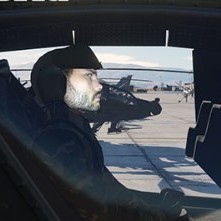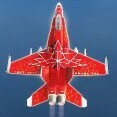-
Posts
1909 -
Joined
-
Last visited
-
Days Won
3
About Raptor9
Recent Profile Visitors
The recent visitors block is disabled and is not being shown to other users.
-
Hello @felixx75, this issue was previously reported internally on a prior date. EDIT: Oh, that must have been you.
-
No worries. These aircraft are hard to learn.
-
-
Both the M60 and M240 machine guns are planned for the DCS CH-47F.
-
@Tom P, posts that are in violation of the forum rules will get removed. Specifically, if it is in violation of Rule 1.10, meaning it is non-constructive, insulting, or condescending, it will be removed. If feedback is provided in a constructive and mature manner, it will not be removed. Simple as that, and this is nothing new. ______________________________________________ In regards to this entire thread, the flight dynamics team will continue to work on the flight model to ensure it meets the quality that is expected of DCS. We understand the frustration with the lack of progress updates, but the lack of updates is not indicative of a lack of progress or development. The complexity of any simulated flight model of a helicopter cannot be over-stated. These things take time, you will need to be patient. If anyone has anything constructive to add to this conversation, then by all means provide it. But if this thread is simply going to turn into a rage against the development process or the ED staff, it will be promptly moderated and closed.
-
@Furiz and @Opesher, I was able to reliably reproduce this issue internally during cold starts and air starts, with several combinations of A-G sub-modes. This issue is now reported. Thank you for your time and assistance; this was a little obscure.
-
So just go straight into EO-PRE without touching the FCR modes or anything? I'll give it another go in a bit. Thanks.
-
@Furiz, thank you for the track. Do you have any mods installed? I tried to reproduce the issue following your steps during a cold start but I could not get the FCR to go to CRM when entering EO-PRE.
-
The device used for recording and the conditions of recording makes a big difference in comparing such things. It's why the EUFD looks green in modern digital cameras when in fact it is more yellow colored in reality, as seen in old film-based photographs, which is reflected in DCS. To answer your question, yes it is authentic, in that if you were to actually wear a real helmet around your head and listen to it in real-life, there would be no detectable difference. However, depending on the quality of your computer audio output device (speaker, headphones, VR headset), it may very well sound quite different from a Youtube video that was recorded on a smartphone while being heard in an open air environment like that. Such comparisons are far from ideal.
-

Issue with FCR Radar Cone Alignment During Flight
Raptor9 replied to Gideon312's topic in DCS: AH-64D
You must press the SLAVE button any time you are trying to slave the TADS, or any sight in the CPG seat, to the selected ACQ source. I guess that was an implied task that wasn't as known as I thought. -

Issue with FCR Radar Cone Alignment During Flight
Raptor9 replied to Gideon312's topic in DCS: AH-64D
Select TADS as your sight, and select FCR as your ACQ to slave the TADS to the FCR NTS target. Alternatively, press the CAQ button on the TSD page and cursor-select an FCR target on the TSD page, which will set T50 at that location, and then slave your TADS to it. -
@Gunslinger52, the FCR is not affected by fog, but it is affected by trees (or urban structures). Pretty much anything with a collision model will block the radar. When I replayed your track, and the T-72's were within the FCR detection range for stationary targets (6 km), there was indeed a moment when George had found a single T-72 despite the tank not appearing on the FCR page. However, within a few seconds he then announced "I don't know where he went". This means that George lost sight of the target, which implies there was intermittent line-of-sight with that tank to begin with, which would be caused by the trees in that area. As you approached closer and there was less tree density between your helicopter and the targets, not only did the FCR start to more reliably detect the targets, but George began discovering more T-72's in the area. This is in line with what should be expected when using the FCR and TADS to detect targets amongst intermittent vegetation densities.
-
@Tom P, it is true that later software versions of the AH-64D permitted the manual entry of a frequency into the standby slot of a given radio. However, the DCS AH-64D is simulating an avionics version that did not have such a function, therefore you are requesting an unrealistic feature for the version of AH-64D being simulated. Further, such upgrades completely changed the logic and layout of the COM page; it wasn't just a few new options here and there. There is a lot of context missing in that video regarding "later software versions". The software version of AH-64 that Casmo flew was quite different than that which is simulated in DCS. As @Floyd1212 mentioned, manually entering two frequencies into the same radio is actually quite easy and quick.
-
It's the Spike NLOS missile, which has been used by Israeli AH-64's and has been recently acquired by the US Army.
-
As this topic has been addressed many times in the past, let me bring up some counterpoints in this debate that tend to be conveniently ignored within the online folklore. First and foremost, no one has supplied any evidence to support the claims that the ALR-56M behavior in DCS F-16C Viper is functioning in an inaccurate manner. As always, if anyone has any public unclassified information that supports these claims, feel free to message BigNewy or NineLine. Otherwise, if no one has actual evidence that the ALR-56M is modeled inaccurately, then such claims are purely speculative. Second, the fact that RWR systems measure signal strength of detected emitters does not imply that the signal strength affects how the symbols are displayed on the RWR display. In fact, many RWR systems measure signal strength, which may be used to detect a change in operating mode of the radar in preparation for firing a missile, among others. RWR systems use a variety of parametrics (depending on their sophistication) to process threat radar signals, such as frequency, pulse repetition frequency, pulse repetition interval, waveform, etc. But how a given RWR system presents these threats to the pilot is widely different between each system, and may even differ between different software versions or configuration within a given nation's military. It is also true that some RWR systems do in fact display symbology to the pilot that indicate relative signal strength. Many older RWR systems that lacked the processing power or radar threat "library" of modern RWR's displayed signal strength and bearing to a radar signal, and it was up to the pilot to interpret this information to determine what threat level the signal posed and whether the radar was potentially tracking the aircraft or guiding a missile toward it. However, as RWR systems became more sophisticated and the pilot's workload to interpret suck symbology to determine threat level could be reduced, many opted to display symbols in a more concise manner to indicate to the pilot the specific type of radar that was out there and when they were under attack, so the pilot could take appropriate defensive action. To that end, most RWR systems are not intended to provide overall situational awareness; rather they are relatively simple devices to provide a pilot the necessary cues to take defensive actions when being tracked or engaged by a radar threat, the nature of such actions may vary based on the type of threat (airborne, SAM, AAA) that is tracking the aircraft. The lack of a way to ascertain signal strength on the RWR display is not aspect of RWR sophistication or generation; it is a byproduct of how a given RWR model and software configuration is designed according to a military's intended requirements to support their pilots and the mission. On the US Air Force F-16 Block 50, a platform designed for Suppression of Enemy Air Defenses, the presence of the HARM Targeting System and the level of integration and situational awareness that the HTS and its related functions provides certainly supports the SEAD mission. Finally, there does indeed seem to be a bug that is present with the F-16 RWR as demonstrated in this video, in that a tracking radar is being displayed in the inner ring, rather than the middle ring as described in the DCS Early Access Guide. Thank you for bringing this to our attention so it can be reported and corrected. Once again, if anyone has any public unclassified evidence to support their claims that the RWR in the DCS F-16C is modelled inaccurately, please DM one of the community managers and we will gladly review it. Otherwise, such claims of inaccuracy are no different than any other claims made by community members that are heresay, speculation, or gameplay preferences.







.thumb.png.f4901cc275acf4b33f415f8f6e2f1a83.png)



